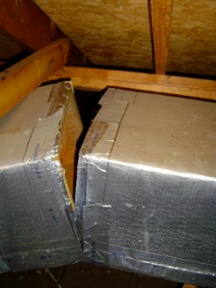An Oversized Cooling System Isn’t Always a Bad Thing

I know, I know. If you’ve had a HERS rater class or any education in residential building science, the alarms are going off in your head right now – WAANNNHHHHH WAANNNHHHHH WAANNNHHHHH! Please, let me explain.
I know, I know. If you’ve had a HERS rater class or any education in residential building science, the alarms are going off in your head right now – WAANNNHHHHH WAANNNHHHHH WAANNNHHHHH! Please, let me explain.
Let’s say an existing home has an old air conditioner that’s on its last legs and needs to be replaced. Since that AC was first put in, the home has gotten better insulation and windows, and maybe the trees that were tiny when the house was new now provide a lot of shade. Maybe the original contractor just put in a way oversized cooling system.
For whatever reason, the AC that needs to be replaced is too big, and that’s been verified by a proper HVAC load calculation, done according to the ACCA Manual J heating and cooling load calculation protocol. (ACCA is the Air Conditioning Contractors of America.)
If all the homeowner does is have the equipment replaced, and they reduce the size so that the equipment capacity matches the load, they may end up using more energy and having a less comfortable home. Can you figure out why?
The answer is duct leakage. Let’s say the house has a duct system with 300 cubic feet per minute (cfm) of duct leakage, and those ducts are in the very humid crawl space. If the old, oversized system ran 20 minutes per hour on a hot day, it would total 6000 cubic feet of duct leakage per hour.
Some of that would be cooled supply air lost to the crawl space, and some would be muggy crawl space air sucked into the return ducts. A typical breakdown is 40% supply leakage and 60% return leakage, so the system would lose 2400 cubic feet of cool air and suck in 3600 cubic feet of muggy air.
Now, the HVAC contractor puts in a right-sized HVAC system, and it runs longer. That should be a good thing because you need longer run times to wring the moisture out of the air. Unfortunately, the duct leakage kills that hypothesis in this case.
Let’s say the new system runs 40 minutes per hour. With the same amount of duct leakage (300 cfm), this system will lose 4800 cfm of cooled air and suck in 7200 cubic feet of muggy air. That longer run time comes with a heavier latent (moisture) load, which the system probably can’t handle.
Does it make sense now? With the old, oversized cooling system, the amount of moisture added to the house by duct leakage wasn’t as bad as with the new right-sized system. The Florida Solar Energy Center (FSEC) has done research on this and showed that putting a right-sized cooling system on a leaky duct system results in worse performance and higher humidity in the house.
The key, as always, is using the systems approach. You can’t tackle only the problems with the equipment. The duct system is also crucial, so when you’re looking at HVAC design, make sure you’ve got properly designed and sealed ductwork as well as right-sized HVAC equipment. HVAC duct design using ACCA Manual D should be the next step after completing the Manual J.
Going back to the title of this post, please understand that I’m NOT saying that the HVAC contractor should install an oversized cooling system to compensate for poor HVAC duct design. I’m saying they have to address both issues. Fix the ducts, and then install a right-sized cooling system. That’s how you do HVAC design the right way.
This Post Has 4 Comments
Comments are closed.

I am wondering about a
I am wondering about a senerio where the HVAC system on a very leaky duct system and the unit does not need replacement. By tightning up the ducts, we by default oversize the existing A/C ( let’s assume a cooling dominated climate). I am lookikng for any research on the energy consumption of this now”oversized” system? Does anyone have any experience or a source for this?
Sorry, for the spelling and
Sorry, for the spelling and grammar errors from previous post
I am wondering about a scenario of an HVAC system on a very leaky duct system and the HVAC unit does not need replacement. By tightening up the ducts, we by default oversize the existing A/C ( let’s assume a cooling dominated climate). I am looking for any research on the energy consumption of this now “oversized” system? Does anyone have any experience or a source for this?
Thom: I
Thom: I don’t know of particular studies, but I’d suggest looking at FSEC’s website. They’ve done a lot of this kind of research.
I just purchased a 70,000 BTU
I just purchased a 70,000 BTU Keeprite furnace and also got a 2ton airconditioner with a 3 ton coil. does this cause any problems?
One installer tells me that will freeze, another installer tells me that if it’s smaller will freeze and the Place were I purchase it tell me that 3 ton is ok, it will not create any problems because it has a (special Valve like a ball floater to controll the ammount of freeon to pass through)I am confused and could appreciate some help.
Thanks in advance
Vincent